I have a small parijat tree in my little garden at home. In fact, one of the selling points of this house, for me at least, was this tree which was just a tiny plant at the time. Over the years the tree has suffered some harsh blows, including some cyclonic storms — it barely survived cyclone Thane! But it perseveres and continues to thrive with some tender love and care.
For the first few years after it had started to blossom and shower its fragrant flowers every dawn, I used to gather the flowers for a specific practice I had developed for myself. I named the practice – Patience through Parijat.
The gracious parijat tree, a sacred tree also known as wish-granting tree, offers to the Earth its most precious gift in the form of beautiful and delicate flowers. And I, a child of this Mother Earth, wanting to grow in my aspiration to become more patient, would gather some of these flowers and bring them indoors for my practice.
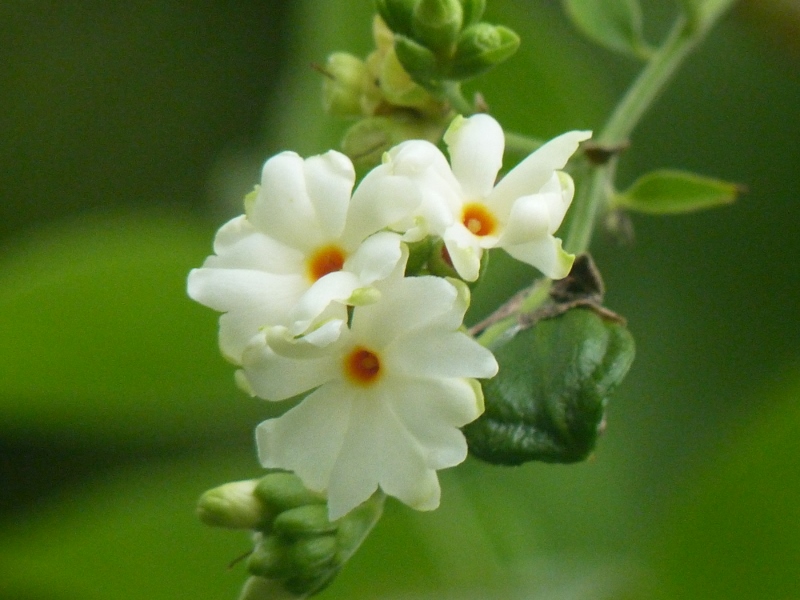
Don’t miss: Aspiration and the Psychic Being
Slowly arranging these tiny and fragrant flowers so that each flower stands white-creamy side up and on its tiny orange foot was my simple practice.
Of course, the first impulse was to gather these flowers in my palm and just immerse myself for a few seconds in their divine fragrance. Having done that, the blossoms which were somewhat soiled by the wet earth needed to be tenderly cleaned making sure that neither their small white-creamy petals nor their tiny orange centers broke. As they would dry out for a bit, I decided upon the appropriate urli or bowl in which to do the arrangement.
Then would start the most favourite task of picking up and arranging these tiny flowers, one by one, white side up, orange side down. My most preferred way was to float these flowers in water. Sometimes for the sake of contrast, I also alternated and put in a few blossoms upside down, but that was very rare. There is something so beautiful about the way the tiny orange center shines through the middle of the white-creamy petals.

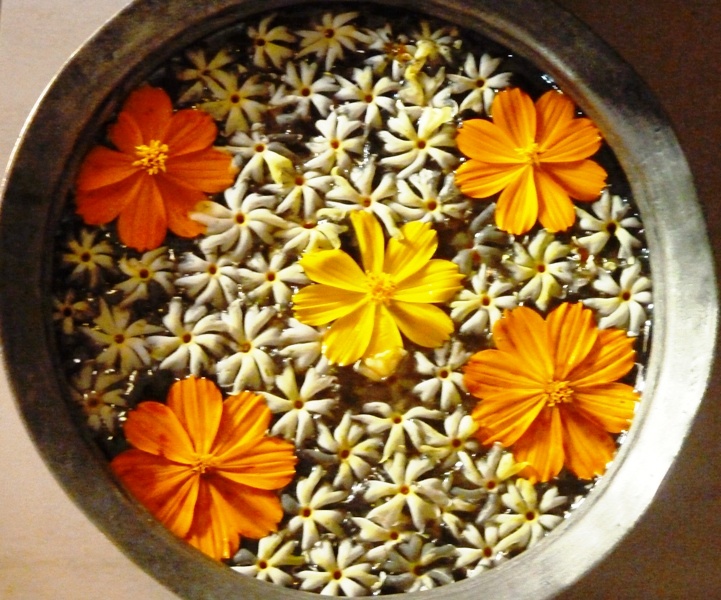
The flowers stayed nice for two to three days, and interestingly even when they began to wither away they just took on a darker creamy shade and didn’t really look so bad. At least to my eyes they didn’t! And when I was ready to give the old flowers and the used water back to the Mother Earth (by way of either putting them in a compost bin or simply sprinkling the flowers and the water under some plant or bush in the ground or in a pot), I would admire this beautiful yellow-orangish coloured water which had taken in itself the vibrant, fiery colour from the flowers.
The orange or saffron center of this sacred flower represents the fire in the heart, the source of all our energy, the fire that purifies, the fire of aspiration, will, and perseverance. It is said that the dye produced from the central part of Parijat flowers was used to colour the robes of monks and ascetics in olden times. And in our times too, we find that the Mother has given to this sacred Parijat flower a most appropriate spiritual significance – Aspiration (Innumerable, obstinate, repeating itself tirelessly).
And when I had just a little patience or wanted my practice session to be really small, I gathered only a small bunch of flowers so that I could do only a small arrangement. Something like this offering to Sri Krishna.

There were also those days when I didn’t feel like doing my lessons. Though on such occasions I would pretend to myself about not having much time, but honestly it was the patience that I lacked or the aspiration or will to practice my lesson in patience. But I still felt like arranging these delicate flowers, the result would look something like this. Or some variant of it.

Read:
Nature Aspires Too – Words of the Mother
After a few years, this practice somehow stopped with some unavoidable change in my personal routine.
But even today I remember clearly that the very act of gathering these tiny flowers one by one from the ground and spending the next half hour or so cleaning and arranging them made me forget whatever pressing demands there were on my time. And in those few minutes there was no hurry, no rush-rush to finish up the task at hand and move on to other things. There was simply a quiet joy of being with the sacred flowers. Giving myself to the moment. A self-giving. And as the Mother tells us, from a purely psychological point of view, aspiration is a movement of self-giving.
Such is the power of flowers. Such is the power of aspiration. Such is the power of the flowers called aspiration!
Also read: Parijat, the Kalpavriksha
The present issue is dedicated to exploring Aspiration.
Sri Aurobindo once said that “the power of aspiration of the heart, the force of the will, the concentration of the mind, the perseverance and determination of the applied energy” are the measure of the intensity of the turning, the force which directs the soul inward (CWSA, Vol. 23, p. 58).
This inward turning of the human soul, away from the egoistic state of consciousness which is constantly absorbed in the outward appearances and attractions toward a higher state of consciousness, to a seeking of that which is beyond and behind the outer appearances, that which can connect one to the Truth and to one’s true Self is the starting point of all Yoga. The fierier and clearer the aspiration, the greater is the force and power of this inward turn.
Aspiration is like an arrow, or like a flame rising upward. But it has to be tended, constantly rekindled. Its direction also needs to be reset when it tends to go here and there. It has to be purified so that no desire or demand gets mixed up with it. Its goal has to be kept in front, always. And what happens when it goes into hiding somewhere? How to light the fire again? And what about the Grace? Will Divine Grace help me rekindle my aspiration? These and many other questions have been explored in the rich variety of selections featured in this issue.
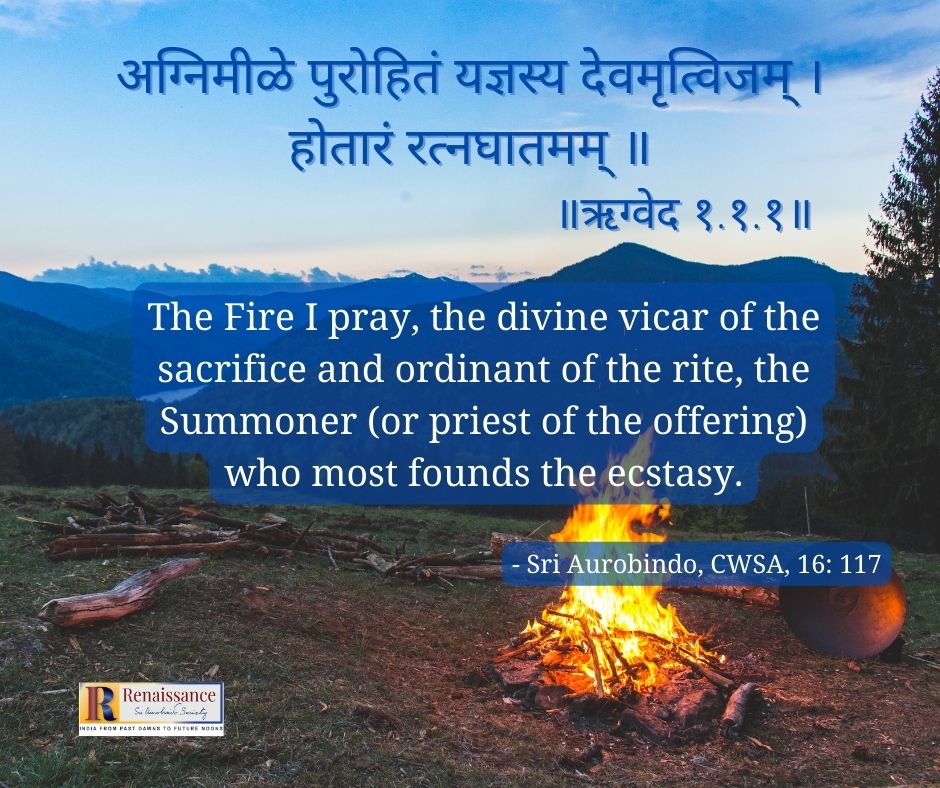
Selections from Sri Aurobindo and the Mother included in our Guiding Light feature speak of a few fundamentals: what is the movement of aspiration; how is it different from desire; is one born with an aspiration or can it be developed; what is meant by the intensity of aspiration; and how does Grace respond to the sadhak’s aspiration.
In the Sunlit Path, we highlight a few more gems from Sri Aurobindo and the Mother which offer practical guidance for the aspirant on the path of Integral Yoga. Another set of selections focus on the Mother’s explanation of what it means to become conscious of one’s psychic being, and how the contact with psychic consciousness gives intensity and joy to the aspiration.
The psychic fire of aspiration, the divine will-force working in man, is symbolised by Agni in the Veda and Upanishads. We feature selections from Sri Aurobindo’s ‘The Secret of the Veda’ which give us a magnificent description of Agni, the flaming godhead. We also learn: what is the work of Agni? How does it lead the aspirant’s inner journey to Truth? How is it born? What are the images given in the Veda which speak of this Divine Will-force?
We feature excerpts from an essay titled Upanishadic Symbolism, in which Nolini Kanta Gupta presents a marvellous summary of the Triple Agni as described in several Upanishads. This is followed by the Mother’s explanation of the triple aspiration. In another selection, Nolini Kanta Gupta gives us the symbolism of a Rig Vedic parable about Agni hiding in the Inconscience and only coming out when gods descend from above.
The first chapter of Sri Aurobindo’s The Life Divine is appropriately titled ‘The Human Aspiration.’ For our Book of the Month, we feature Dr. Ananda Reddy’s deliberations on this chapter excerpted from the first volume of his multi-volume series ‘Deliberations on The Life Divine’. His helpful commentary on the first chapter from Sri Aurobindo’s philosophical magnum opus is presented in two parts.
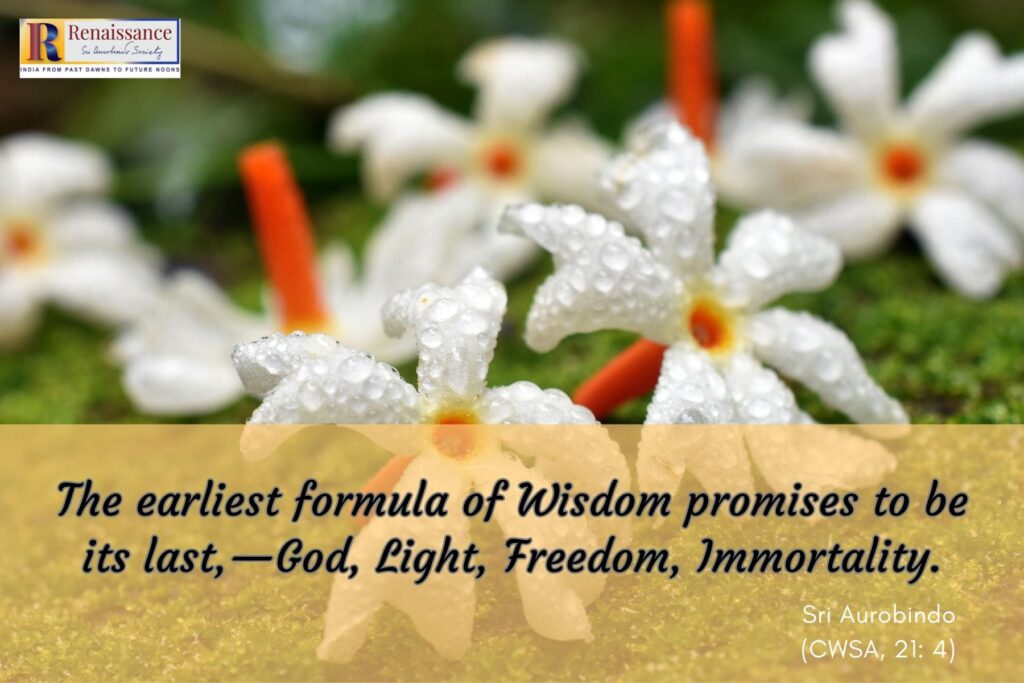
For the Sādhanā series, we bring to you a beautiful artwork sent to us by Navaja Llope which inspired our selection of the Mother’s words for this feature. The Mother’s words describing the ardent aspiration seen in nature — in trees, animals and particularly the flowers — make for another delightful reading.
How does the story of Sri Krishna bringing down to earth the heavenly tree of Parijat connect with the spiritual significance of this divinely fragrant flower? This is the subject of our flower meditation this month by Sheeba Naaz.
In our Insightful Conversations this month, we have Dr. Aditi Kaul sharing with us about her experience of working with college students on Indian approach to psychology. We also get some keen insights on the value of subtle influence of the teacher, and self-exploration as a pedagogical approach.
We bring for our readers three poems this month, in three different languages. The first one is a very special one by Dr. Murlidhar Chandniwala, a renowned Sanskrit and Hindi scholar. For decades Dr. Chandniwala has been translating and re-expressing Vedic mantras in Hindi poetry. His poem inspired by RV 2.1, a sukta of 16 mantras to Agni revealed to Rishi Gṛtsamada Bhārgava Saunaka, is presented in this issue.
A young aspirant and poet, Imran Ali Namazi, while expressing his aspiration for a divine life on earth, his dream of a new world based on a new consciousness of unity, harmony, bliss, and progress, invites all who wish to walk the path of self-perfection for perfecting the world outside.
Our third poem is in Urdu penned by Harvinder Pal Kaur, and it expresses her aspiration to feel and see and experience the Divine Presence in all and everything around and within her.
Part 7 of Rajeshwari’s ongoing series – सर्वे सन्तु निरामयाः – May All be Free from Illness goes deeper into the need for balancing the panchabhutas or five elements within for an optimal health. We conclude today our other series – Sri Aurobindo on Isha Upanishad by M. P. Pandit. In perfect tuning with this issue’s theme of Aspiration, the last 2 verses of Isha Upanishad are Rishi’s powerful invocations to Gods Surya and Agni who alone can uplift him and open still higher vistas of Light and Power leading to the final goal of Immortality while still living on earth for a full span of life.

I close this editorial with two passages to which I keep going every time I feel my aspiration needs a booster. Every time I read these passages, gratitude fills my being and the flame within gets a fresh dose of necessary food.
The first one is by the Mother who in her Divine Straightforwardness reminds us “not to give up the game”. She tells us:
. . . if the aspiration is there in you, if the will is there in you, it is absolutely certain that sooner or later you will succeed. And I am saying this for people who live in very ordinary circumstances, less favourable perhaps than yours, but who can, even so, learn to know themselves and conquer themselves, master themselves, control themselves.
Therefore, if the conditions are favourable you have a much greater chance of succeeding. One thing is always necessary, not to give up the game for it is a great game—and the result is worth the trouble of playing it through.
~ CWM, Vol. 12, p. 53
And the other one is a surprisingly simple and profound formula given by Sri Aurobindo in a correspondence with Nirodbaran. In a way, here he summarises the whole Yoga is so perfectly, so beautifully. Many people feel that Sri Aurobindo is difficult to understand, but if only they had come across this one exchange, everything would be so simple!
This is how the conversation goes:
Sri Aurobindo: “. . . within there is a soul and above there is Grace. This is all you know or need to know. . .”
“Q: “Is that all, really?”
Sri Aurobindo: “For anyone who wants the spiritual life, yes, it is enough.”
~ Nirodbaran, Correspondence with Sri Aurobindo, Complete Set (2001), Vol. 1, p. 465
What is left unsaid here is that the soul must aspire!
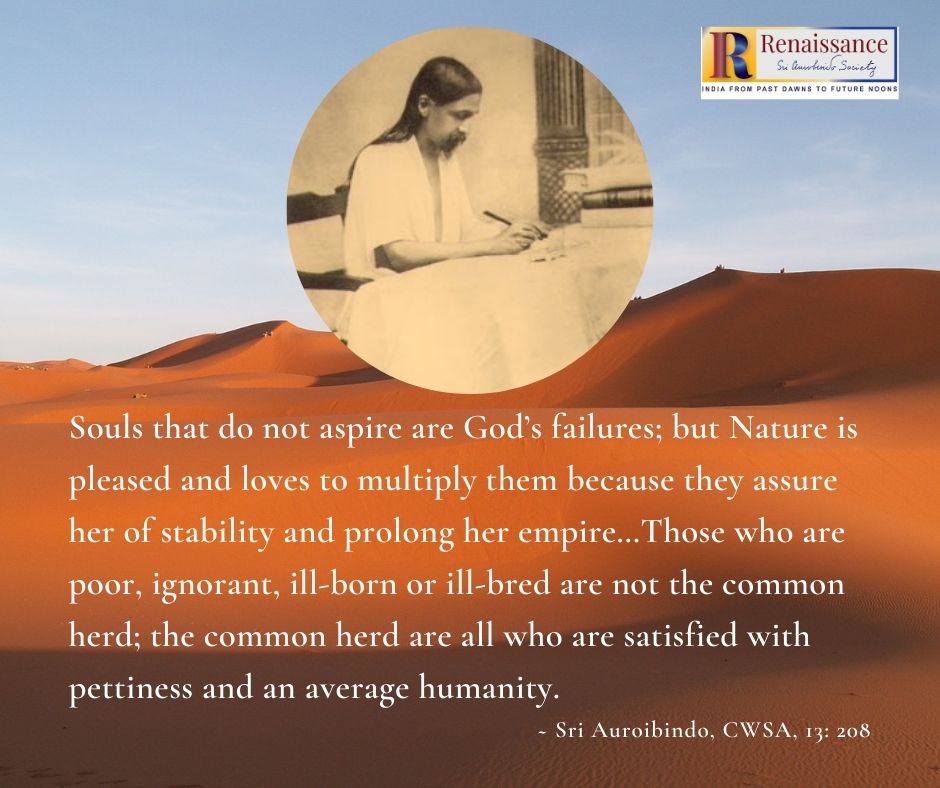
We hope that our readers will find value and inspiration in this issue’s offerings. As always, this work is offered at the lotus feet of Sri Aurobindo and the Mother.
In gratitude,
Beloo Mehra (for Renaissance Editorial Team)

~ Design: Beloo Mehra



